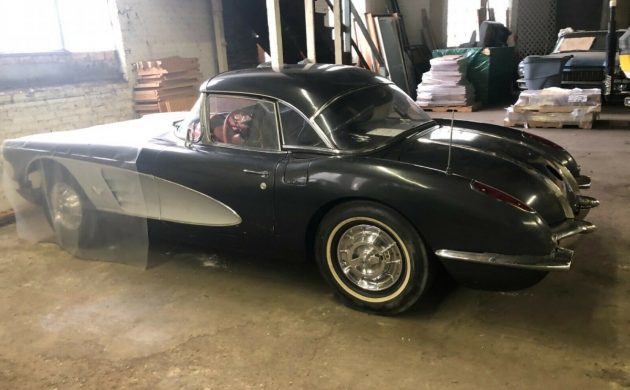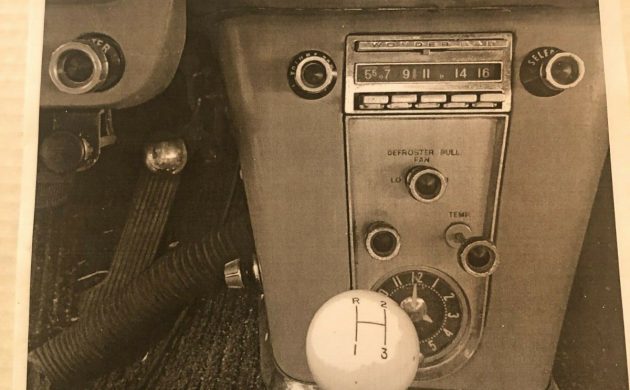When you consider that Chevrolet sold a record 9,168 examples of the Corvette in 1958, it is staggering to think that the company was poised to ax the program only three years earlier. Initial sales were modest (to be polite), and it was conceivable that a badge that would eventually become an American icon nearly faded into obscurity. Today, early Corvettes command some eye-watering prices, and project cars can generate significant interest when they hit the market. Our feature car is one such vehicle, and it looks to be a promising project. Located in Batavia, Illinois, the owner has listed this classic for sale here on eBay. Surprisingly, it has only received two bids at the time of writing, pushing the price to $40,000. Since the owner indicates that this figure is the reserve, a new home is closing fast on this Corvette.
The seller states that this Corvette’s Tuxedo Black paint is original. Only 493 cars wore that shade in 1958, representing a take-up rate of 5.4%. However, its rarity runs slightly deeper thanks to the original owner’s decision to specify Silver coves. This combination found its way onto a mere 199 vehicles, or 2.2% of total production. That fact alone would help justify a faithful approach to this project. The fiberglass is in good condition for its age, with no issues or evidence of prior repairs. Rust is not a problem worth considering because the owner believes that the frame and birdcage are structurally sound. He purchased the car eight years ago, intending to perform the restoration that had stalled under the previous owner’s watch. The body currently sits on the frame, making the possibility of a nut-and-bolt refurbishment a tempting proposition for potential buyers. Adding to its appeal, this Corvette comes with both a soft-top and a factory hardtop that is in good condition. It appears that most of the trim is restorable, and the glass looks good.
I would love to tell you that this Corvette is numbers-matching, but sadly, that isn’t the case. The freshly rebuilt 283ci V8 started life in a 1961 Bel Air, and I think it is backed by a non-original three-speed manual transmission and replacement rear end. The engine’s specifications are unclear, but the owner indicates that it starts and runs. The car hasn’t seen active duty since 1972, so it shouldn’t be considered roadworthy. The trunk contains a dual-quad intake and one of the correct carburetors. If the buyer can locate another, that setup should unleash additional extra horses that won’t go astray. It is worth remembering that the loss of the original motor could have some impact on the Corvette’s ultimate value. The engine change is also why I refer to this as a refurbishment rather than a restoration.
Most of the Corvette’s interior hardware, like seat frames and the dash, are present, although the seller scrapped the Charcoal and Red upholstery due to it smelling bad. Replacement upholstery is readily available, but it isn’t cheap. A basic kit sells for around $1,400 but only includes seat covers, door trims, and carpets. To return the interior to showroom condition, a kit of that caliber can cost $4,000. However, the buyer won’t need to search for items like a gauge cluster, clock, or original Wonderbar radio. These items are intact and appear to be in a restorable state.
If you wander out into today’s market, it is common to find C1 Corvettes commanding prices beyond $80,000. For the right car in original condition, that can easily jump into six-figure territory. The loss of the original drivetrain will impact this classic’s potential value, but a high-quality refurbishment could still see a value of $70,000 as achievable. If the car sells for somewhere around the current bid level, that will leave a fair stash of cash in the bank before its financial viability becomes questionable. With those thoughts in mind and the reserve now met, are you tempted to pursue this Corvette further?







Looking for a 48 or 49 Cadillac hearse to fix up original. Thank yall I like the one at the beginning of this post and no I am not wealthy just an old man wanting something to tinker on.
Just no.
Original paint over the VIN tag?
Stainless trim from a ’59 – ’60 hardtop?
No photos showing the hood fit, chassis condition, or nose fiberglass?
Black and white, upside down, and sideways photos?
One blurry photo that could be the Loch Ness Monster?
Can’t pick up until April 30?
Chebby passenger car drivetrain?
Disassembled (incomplete?) soft top frame?
Threw away the METAL seat FRAMES because they “smelled bad”?
“Weld the springs on and drive it.” Wut?
Run, Forrest, RUN!
The only interesting features of this car are the 8,000 rpm tach and the front air duct openings, and both of those could have been added.
the first thing I always do to a car is weld the springs on. new or old. make sure those are welded on real nice. hahaha
The seat frames are there, it’s just the old covers, batting, foam etc that he threw away because they “smelled”.
I know there are differences in 56 and 57 hardtops (bare aluminum header on early 56’s, the little “Y” molding where the quarter and rear window moldings meet on 56 & 57’s, that’s not on 58-60’s), but I thought 58-60’s are the same except for the headliner?
I need help to find the seat frames. I’ve studied his eBay photos, and all I see are some seat cushion spring supports. No stock ’58 Corvette seat frames or runners.
The new NCRS ’58 – ’60 Judging Guide says ’58 and early ’59 hard tops used the “Y” joiner pieces as well as the ’56 – ’57 models.
The car looks charcoal to me, too. This may be a decent body with a rust-free chassis… but you sure can’t tell it from the crappy photos posted on eBay.
The seller says the paint is original, he does not say that it’s black. It looks to be Charcoal to me, and the seller says the car is “charcoal/red int.”, as in charcoal with a red interior.
What the color is doesn’t really matter, since 53-62 Corvettes didn’t have trim tags, there’s no real extra value to a low production color. Looking at the paint, I don’t believe it’s the original paint anyway. From multiple cracks in the paint, it has the look of an old repaint using many thick coats of lacquer. Also, on a car with original paint, the VIN tag would have a natural, unpainted finish, not be covered with multiple coats of paint, like the tag on this car. VIN tags were installed after the car was painted.
Solid axle Corvettes rarely have rust problems with the birdcage or frame. In 45+ years of playing with early Corvettes, I’ve only ever seen one with a bad birdcage, a 54 that had been sitting outside, uncovered, since 1978.
Overall it doesn’t look like to bad a car for the money. The replacement engine’s not the issue in a 58, that it is in later years. GM didn’t start stamping the block with a VIN till mid 1960, so it’s fairly easy to find a correct dated block to build as a “matching numbers” engine.